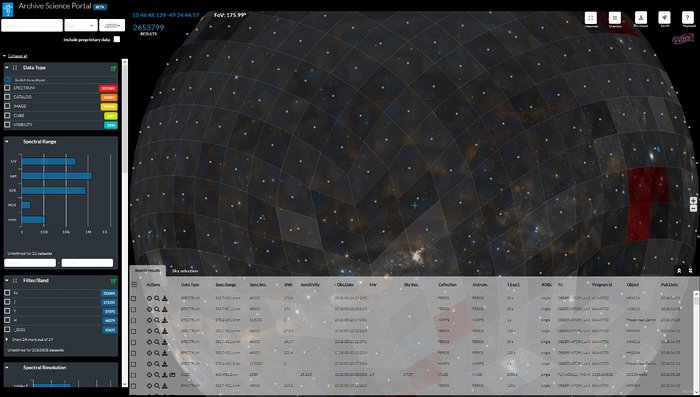ESO Science Archive
Scientific data collected at ESO’s observatories is freely and openly accessible online through the ESO Science Archive. In addition to the raw data straight out of our instruments the ESO Science Archive also contains 4 million processed science files available for use by scientists and astronomy enthusiasts worldwide.

ESO Science Archive Facility. Credit: ESO/H.H.Heyer
Modern telescopes are equipped with instruments that lead to massive amounts of astronomical data, from images to spectra and catalogues of astronomical sources. These datasets cover the sky at all wavelengths from gamma- and X-rays, through optical and infrared, to radio waves. Astronomers and engineers are developing ways to do new science, by storing and managing these data in a way that is easily accessible and reusable.
ESO owns and operates over 30 optical and infrared instruments at its observatories in La Silla and Paranal, in Chile. In addition, until 2022 ESO was a partner in the Atacama Pathfinder Experiment (APEX) on the Chajnantour plateau, which observes the sky at millimetre and submillimetre wavelengths. These facilities produce around 160 TB of data per year. ESO is also a partner in the Atacama Large Millimeter/submillimeter Array (ALMA), which features 66 antennas operating in the millimetre and submillimetre range. ALMA is one of the largest astronomical observatories in the world and produces around 300 TB of data each year.
All science data collected at La Silla and Paranal, as well as data collected at APEX until mid-2023, are accessible online through the ESO Science Archive, which is physically located at the ESO Headquarters in Garching, Germany. Data from the ALMA observatory are also directly accessible from the ESO archive and can be queried together with the data from other ESO observatories. ESO also hosts and operates the European copy of the dedicated ALMA Science Archive.
Open, reusable data
ESO fosters open access to these scientific data and optimises the reuse of such data by ensuring it’s findable, accessible, interoperable and reusable (FAIR principles). The Principal Investigators of successful proposals for observing time on ESO telescopes generally have exclusive access to their scientific data for the duration of a proprietary period (typically, one year). Afterwards, the data are accessible to astronomers worldwide via the ESO Science Archive, retaining ESO’s copyright and being distributed under a Creative Commons Attribution license. The ALMA Science Archive operates under similar principles. This means that data on a specific astronomical object acquired using different ESO facilities, operating at different wavelengths, can be directly compared and combined to provide more information about that object.
The number of papers that use partly or exclusively archival data has increased continuously during recent years, reaching almost 40% in 2022. In particular, 24% of papers relied on archival data alone, without any ESO observations obtained by the authors themselves. These figures demonstrate the important legacy value of the ESO Science Archive.

ESO Archive Science Portal. Credit: ESO
ESO Science Portal: the home of processed data
The raw data captured by an astronomical instrument cannot be used for scientific purposes straight away, because our atmosphere, the telescope and the instrument all leave certain imprints that need to be measured and corrected for. This is done via special calibration data that is routinely taken for all ESO instruments and then stored in the ESO archive.
The raw and calibration data can be then combined and transformed into science-ready data using software tools called data reduction pipelines. ESO maintains a suite of pipelines for different instruments, which can be freely downloaded. This is key to ensuring that scientific results can be replicated by anyone, as well as to enable new discoveries from old data.
Astronomers often have to explore complex datasets to find what they are looking for, and it would be very inefficient if they had to constantly process everything themselves. Therefore, in addition to raw data and the associated calibrations, the ESO archive also contains processed data that can be accessed through a dedicated Science Portal, an interactive, browser-based sky interface allowing anyone to quickly search for, and obtain, astronomical data from ESO’s telescopes. Besides being an invaluable resource for professional astronomers, it also allows enthusiasts to download processed files and, for instance, combine them into amazing colour images.